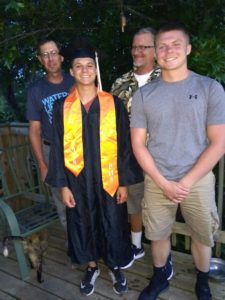We’re in our 20th year at Coyote Run Farm. Below is a history of our farm and the investments we’ve made to rehabilitate this 1930s farmstead into a 21st Century sustainable farm. We have a few more years to include. This goes through 2021.
Coyote Run Farm came into being in January 2005 when we bought the 110 acre farm in Southwest Marion County. We believed people would buy high quality, sustainably-raised foods and products from a small family farm, especially if they could connect with that farm on an ongoing basis.
The property was an intact farm from the 1930s. Conventional wisdom would have been to bulldoze the buildings and add this small farm to existing farms for commodity agricultural production.
We had a different plan. We bet the farm that with a commitment to sustainable agriculture and a desire to build relationships with customers buying directly from the farm, we could transition this dying farm into a modern and profitable agricultural enterprise.
During our first year, we both continued to work in Des Moines and spent our time getting to know the land, making plans for our enterprises, and amending the soil in our market garden beds.
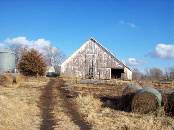
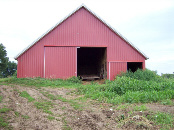 In year two, Pat left his job as zookeeper to farm full time. We took the Grow Your Small Market Farm class and started selling at the Downtown Farmers Market. At the end of our second year, we invested in the barn. Built in the ‘30s, the barn still held the milking stanchions along with stalls for the draft horses. We hired an Amish work crew to straighten the sides, create new doors for tractor access, and to put steel on the sides and roof. We now have a red barn that we use for hay, livestock, and drying vegetable crops that can stand for another 75 years and beyond. Oh yeah, and the cats love it too.
In year two, Pat left his job as zookeeper to farm full time. We took the Grow Your Small Market Farm class and started selling at the Downtown Farmers Market. At the end of our second year, we invested in the barn. Built in the ‘30s, the barn still held the milking stanchions along with stalls for the draft horses. We hired an Amish work crew to straighten the sides, create new doors for tractor access, and to put steel on the sides and roof. We now have a red barn that we use for hay, livestock, and drying vegetable crops that can stand for another 75 years and beyond. Oh yeah, and the cats love it too.
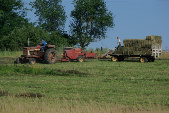 2007 was the year we bought our hay equipment, hit the accelerator on fruit and vegetable production, and signed up for the Environmental Quality Improvement Program (EQIP–a federal conservation program) to transition all but a few acres of our farm into a rotational grazing system. We also continued to tear apart old fence and some older buildings that couldn’t be repaired.
2007 was the year we bought our hay equipment, hit the accelerator on fruit and vegetable production, and signed up for the Environmental Quality Improvement Program (EQIP–a federal conservation program) to transition all but a few acres of our farm into a rotational grazing system. We also continued to tear apart old fence and some older buildings that couldn’t be repaired.
In 2008 we started our EQIP projects by building two ponds for wildlife, soil conservation, and most importantly as a water source for our livestock expansions. We also used the Conservation Reserve Program (CRP–another federal conservation program) to protect a deep ravine 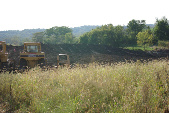 running through the farm from livestock. We have a deep passion for holding our soil on the farm and for providing habitat for wildlife and a diversity of native plants. The torrential rains in 2008 confirmed the importance of these conservation practices and reinforced our plan to develop a diversity of enterprises to build a profitable farm.
running through the farm from livestock. We have a deep passion for holding our soil on the farm and for providing habitat for wildlife and a diversity of native plants. The torrential rains in 2008 confirmed the importance of these conservation practices and reinforced our plan to develop a diversity of enterprises to build a profitable farm.
We said goodbye to the two car garage in 2008 and hello to a processing facility. Finished in 2009, the transitioned garage became a green house, storage facility, and work area for starting plants and handling vegetables. We also added the water systems, built the CRP fences, and started selling beef at the farmers market along with the eggs and produce we’d sold the previous three years. The turkeys also got a new building from recycled materials. And opening a new chapter, we celebrated our first successful grass finished beef with rave reviews from happy customers.
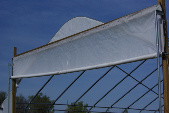 In 2010, we started rehabilitating the house and added a high tunnel to extend our produce season. We sold several equines, expanded our beef production, and continued to hire occasional help from neighbor kids and friends-between-jobs, as well as hosting work parties for friends, family, and customers. Work parties include a few hours of work such as planting garlic, butchering chickens, making hay, or pulling weeds, followed by a big farm meal.
In 2010, we started rehabilitating the house and added a high tunnel to extend our produce season. We sold several equines, expanded our beef production, and continued to hire occasional help from neighbor kids and friends-between-jobs, as well as hosting work parties for friends, family, and customers. Work parties include a few hours of work such as planting garlic, butchering chickens, making hay, or pulling weeds, followed by a big farm meal.
We finished all the components of our EQIP contract in 2011 and now have 90 acres of the farm in pasture or hay. That year we also harvested a full season of produce out of our high tunnel, and expanded our laying hens into two flocks totaling about 300 birds. We had five of our ten cows at our farm, the other five remained at Matt’s parents’ farm where his brother Todd and sister-law-Kathy are now farming and managing the grain finished beef production. We butchered four grass finished beef in 2011.
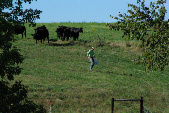
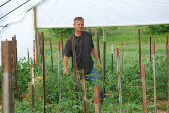 2012 was the first year in many that we didn’t have a huge project on the farm. We took on a farm intern, which provided some much needed help. Matt Butler also brought along some great carpentry skills and built us a great mobile chicken building and will complete a second in 2013. With his help and the neighbor kids, we harvested record crops of tomatoes, potatoes, and garlic. We fought the historic drought starting in early July when both wells went dry. Fortunately we also have access to rural water. As for produce, we learned that most crops like dry weather with irrigation rather than deluges for weeks on end as we had in 2011 and several previous years. The drought was a wakeup call that we definitely need to sell some mules. We butchered seven grass finished beef in 2012.
2012 was the first year in many that we didn’t have a huge project on the farm. We took on a farm intern, which provided some much needed help. Matt Butler also brought along some great carpentry skills and built us a great mobile chicken building and will complete a second in 2013. With his help and the neighbor kids, we harvested record crops of tomatoes, potatoes, and garlic. We fought the historic drought starting in early July when both wells went dry. Fortunately we also have access to rural water. As for produce, we learned that most crops like dry weather with irrigation rather than deluges for weeks on end as we had in 2011 and several previous years. The drought was a wakeup call that we definitely need to sell some mules. We butchered seven grass finished beef in 2012.
In 2013, we experienced every extreme weather condition with a blizzard in May, another drought in August, a cold July, and then the hottest September on record. We butchered the seventh and final grass finished beef in October. After being at the farmers market every week for seven years, we took 10 weekends off in 2013. That proved to be a good move with expanding our Wednesday delivery to all year long. We also further developed restaurant sales to La Mie, Lucca, and HoQ Restaurant.
In 2015 our two summer workers Austin and Devon Flesher moved in as school started and became members of Coyote Run Farm. Austin graduated from Pleasantville High School in 2017, Devon in 2018.
In 2021, we are beginning to incorporate carbon farming into our farming operation. We are partnering with Iowa State University on a biomass project with 7 acres of pasture that we’re transitioning to prairie.
We are also excited about the efforts by the new Biden-Harris administration to invite farmers into helping solve the climate crisis. We were fortunate to have both President Biden and Vice President Harris at our farm in 2019.
As we pursue our goals, we’ve found tremendous encouragement from our friends and supporters. Coyote Run Farm allows Matt to celebrate being a fifth generation Iowa farmer and challenges Pat to continuously expand his animal care and gardening skills. We’re investing in rural Iowa. We continue to bet it’s possible to own and operate a profitable, small family farm that sustains natural resources. And the most important characters in this evolving story are our customers who continue to purchase our products and support us in countless ways.


